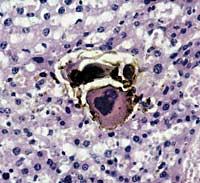Teaching treatment melanoma
Chemotherapy has been replaced for years with biochemotherapy to treat melanomas. In biochemotherapy, in addition to the usual agents, substances are supplied to strengthen the patient's immune system. The goal is for the patient to have a powerful immune system to fight cancer.

The influence of some of these activating substances and biochemotherapy itself are now questioned. Compared to chemotherapy, biochemotherapy does not prolong the patient's life, so activating substances are on the way to drug elimination.
Does it harm or benefit?
In Leioa, however, in 1992 they realized that one of these activating substances had harmful effects. This is the substance Interleuzina-2 (IL-2). This substance activates the immune system, but also the proliferation of tumor cells. Consequently, metastasis spreads further and the patient does not benefit.
Nevertheless, Leioa researchers did not choose to rule out this substance. In fact, they considered that proper use could have a positive effect, that is, that their action had to be modulated.
Studies began to see the processes that the IL-2 agent causes in cells. They realized that IL-2 elevates intracellular glutathione (GSH), an element that accelerates cell proliferation. But this compound is present in all cells, not only in healthy cells. That is why metastasis also spreads.
Therefore, in order for the influence of the IL-2 agent to be positive, the glutathione of the cancer cells had to be reduced in another way, which was achieved with the compound oxotiazolidin-karboxylate (OTZ).
Looking for the model
The compound OTZ had an important role, only to reduce the glutathione of cancer cells to the margins of healthy ones. To achieve this, it is necessary to find a suitable pattern of treatment, since the effect varies greatly if one substance is given before or after another.
After several years of trials, researchers have found the right model: first the protective OTZ, then the chemotherapy agent, and finally the IL-2. This is not a single dose, the model is more complex, but must be issued in that order.
Following this model, researchers have also managed to reduce the most important problem of chemotherapy, toxicity. This means that the dose of chemotherapy may increase and therefore have a longer life if research progresses. Quality of life would also improve with the new treatment.
All this has been tested for years of testing. They started with the mouse and now work with human cells in in vitro tests. All of them have obtained positive results, so it is worth noting the conclusion that a substance should not be discarded immediately, since it may not be the same substance but its inappropriate use.
- The project is entitled Biomodulation
of the activity of chemotherapy agents, radiation therapy and immunotherapy in the treatment of metastases by regulating the degree of simultaneous glutation of tumor and healthy cells. - Objective To increase
the benefit of anticancer agents by selective modulation of the level of Glutation. - Directed by
Teodoro Palomares and Ana Alonso-Varona. - Working group
P. Bilbao, I. Garc a-Alonso, J. Gonz lez, B. Castro, M. Basterretxea, R. San Isidro. - Areas
of Cell Biology.
Surgery, Radiology and Physical Medicine. - Faculty
of Medicine and Dentistry (Leioa). - Funding
UPV, F.I.S, Gangoiti Barrera Foundation.






